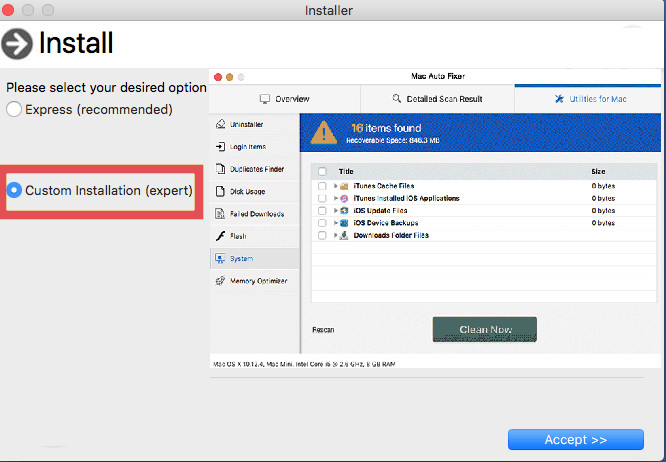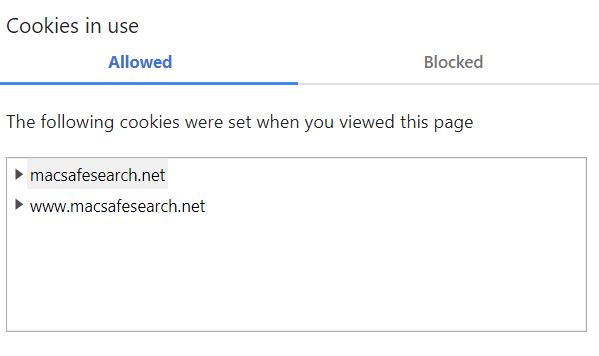What Is InformationLeader on Mac?

According to reports generated by anti-malware tools, InformationLeader is an adware program that affects macOS. This is a potentially unwanted program that supports shady advertising practices. It lands on Mac machines without any notifications to modify certain settings that affect how installed web browsers work. As a consequence, the program grants itself permission to inject different adverts that could endanger the overall system security. Links to dangerous websites could be shown to you. Various online scams, as well as risky pages that push rogue/malicious apps, may be promoted by the adware. Here is why this program should be removed from the macOS as soon as possible.
Read this article to learn how to remove the InformationLeader adware from your Mac and clean up all the annoying ads.

InformationLeader Mac – Details
| Name | InformationLeader also known as Adware.MacOS.InformationLeader |
| Type | Adware, PUP |
| Short Description | The app modifies computer and browser settings in order to receive tha chance to trigger browser redirects and display different advertisements. |
| Symptoms | The infected device begins to display various types of online advertisements. It becomes slow and remains less secured for as long as the adware is running on it. |
| Distribution Method | Software bundles. Web pages which advertise it as a legitimate tool. Fake software updates. |
| Detection Tool |
See If Your Mac Has Been Affected by InformationLeader
Download
Malware Removal Tool
|
InformationLeader Adware – How Did I Get Infected?
The program InformationLeader is part of a bigger threat family for Mac called AdLoad. This family of threats consists of many ad-supported apps that impact macOS security. Other recently detected names are CommonBrowser, PartnerPixel and Colossusaspect. The common between all AdLoad apps is that they show a lot of bogus ads aiming to generate profit for their operators.
The spread of potentially unwanted programs like InformationLeader is typically realized via the method known as software bundling. This means that the chance of you allowing InformationLeader adware to run on your Mac by installing another supposedly useful app is very gigantic. There are pretty lots of free apps that pretend to be useful but in fact, aim to add undesired apps to computer systems. Such apps may be hosted on third-party websites or torrent networks:
The installation package of InformationLeader adware may have been presented to you as a fake Adobe Flash Player update as well. Webpage designed as the one shown below might have tried to trick you into believing that the fake message aims to help you update an outdated app installed on your macOS:
InformationLeader PUP – What Does It Do?
What the activation of InformationLeader PUP on a macOS leads to is modifications of various settings. Both system and web browsers settings may be impacted by the adware. For example, main browsing preferences may be altered – the homepage, new tab page and default search. As a result, the affected browser may start to redirect all your searches to Yahoo or force you to use a hoax search engine.
The software may also start to deliver intrusive adverts of different types:
- Intrusive push notifications.
- Pop-ups with video and/or sound.
- Changed search results to show ads instead of relevant sites.
- Highlighted text on the pages you visit.
- Redirects.
- Interruptive banner ads.
- Banner ads.
Note that different types of trackers like cookies, pixels, web beacons and other may be added to your infected macOS to harvest and transfer specific data to remote C&C servers:
These trackers can get information about your browsing activity. Once obtained by fraudsters these details can be misused for the launch of targeted advertising campaigns against you. Here is an example list of details that may be harvested by adware and provided to fraudsters:
- Bookmarked websites.
- The browsing history from your browser.
- All searches you have made.
- IP addresses.
- What you have visited.
- Mouse movements.
- Mouse clicks.
Is InformationLeader a Virus?
Adware is not a malicious type of app. Hence, InformationLeader is not a malicious program that will act as a severe virus for Mac. But, keep in mind that the program is reported as one that poses danger to macOS security. The explanation is that the program could be used by its operators maliciously. InformationLeader adware could show advertisements that link to poorly secured, untrustworthy, or risky websites. It can invade your privacy by harvesting sensitive data.
This is the main reason why this program has been classified as an indirect threat to your Mac and should be removed from it.

How to Remove InformationLeader from Mac?
InformationLeader can be deleted from your Mac if you follow the removal guide that has been posted beneath this article. It contains the steps that support the full uninstall of unwanted software from both your Mac and the web browsers you use. For the most effective removal, security professionals strongly recommend the use of a reputable anti-malware tool. After it scans your device, it will show all detections that lowe macOS security and endanger your privacy. Then you can remove all of the detections and be sure that your system is clean and secured.
Steps to Prepare Before Removal:
Before starting to follow the steps below, be advised that you should first do the following preparations:
- Backup your files in case the worst happens.
- Make sure to have a device with these instructions on standy.
- Arm yourself with patience.
- 1. Scan for Mac Malware
- 2. Uninstall Risky Apps
- 3. Clean Your Browsers
Step 1: Scan for and remove InformationLeader files from your Mac
When you are facing problems on your Mac as a result of unwanted scripts and programs such as InformationLeader, the recommended way of eliminating the threat is by using an anti-malware program. SpyHunter for Mac offers advanced security features along with other modules that will improve your Mac’s security and protect it in the future.

Quick and Easy Mac Malware Video Removal Guide
Bonus Step: How to Make Your Mac Run Faster?
Mac machines maintain probably the fastest operating system out there. Still, Macs do become slow and sluggish sometimes. The video guide below examines all of the possible problems that may lead to your Mac being slower than usual as well as all of the steps that can help you to speed up your Mac.
Step 2: Uninstall InformationLeader and remove related files and objects
1. Hit the ⇧+⌘+U keys to open Utilities. Another way is to click on “Go” and then click “Utilities”, like the image below shows:

2. Find Activity Monitor and double-click it:

3. In the Activity Monitor look for any suspicious processes, belonging or related to InformationLeader:


4. Click on the "Go" button again, but this time select Applications. Another way is with the ⇧+⌘+A buttons.
5. In the Applications menu, look for any suspicious app or an app with a name, similar or identical to InformationLeader. If you find it, right-click on the app and select “Move to Trash”.

6. Select Accounts, after which click on the Login Items preference. Your Mac will then show you a list of items that start automatically when you log in. Look for any suspicious apps identical or similar to InformationLeader. Check the app you want to stop from running automatically and then select on the Minus (“-“) icon to hide it.
7. Remove any leftover files that might be related to this threat manually by following the sub-steps below:
- Go to Finder.
- In the search bar type the name of the app that you want to remove.
- Above the search bar change the two drop down menus to “System Files” and “Are Included” so that you can see all of the files associated with the application you want to remove. Bear in mind that some of the files may not be related to the app so be very careful which files you delete.
- If all of the files are related, hold the ⌘+A buttons to select them and then drive them to “Trash”.
In case you cannot remove InformationLeader via Step 1 above:
In case you cannot find the virus files and objects in your Applications or other places we have shown above, you can manually look for them in the Libraries of your Mac. But before doing this, please read the disclaimer below:
1. Click on "Go" and Then "Go to Folder" as shown underneath:

2. Type in "/Library/LauchAgents/" and click Ok:

3. Delete all of the virus files that have similar or the same name as InformationLeader. If you believe there is no such file, do not delete anything.

You can repeat the same procedure with the following other Library directories:
→ ~/Library/LaunchAgents
/Library/LaunchDaemons
Tip: ~ is there on purpose, because it leads to more LaunchAgents.
Step 3: Remove InformationLeader – related extensions from Safari / Chrome / Firefox









InformationLeader-FAQ
What is InformationLeader on your Mac?
The InformationLeader threat is probably a potentially unwanted app. There is also a chance it could be related to Mac malware. If so, such apps tend to slow your Mac down significantly and display advertisements. They could also use cookies and other trackers to obtain browsing information from the installed web browsers on your Mac.
Can Macs Get Viruses?
Yes. As much as any other device, Apple computers do get malware. Apple devices may not be a frequent target by malware authors, but rest assured that almost all of the Apple devices can become infected with a threat.
What Types of Mac Threats Are There?
According to most malware researchers and cyber-security experts, the types of threats that can currently infect your Mac can be rogue antivirus programs, adware or hijackers (PUPs), Trojan horses, ransomware and crypto-miner malware.
What To Do If I Have a Mac Virus, Like InformationLeader?
Do not panic! You can easily get rid of most Mac threats by firstly isolating them and then removing them. One recommended way to do that is by using a reputable malware removal software that can take care of the removal automatically for you.
There are many Mac anti-malware apps out there that you can choose from. SpyHunter for Mac is one of the reccomended Mac anti-malware apps, that can scan for free and detect any viruses. This saves time for manual removal that you would otherwise have to do.
How to Secure My Data from InformationLeader?
With few simple actions. First and foremost, it is imperative that you follow these steps:
Step 1: Find a safe computer and connect it to another network, not the one that your Mac was infected in.
Step 2: Change all of your passwords, starting from your e-mail passwords.
Step 3: Enable two-factor authentication for protection of your important accounts.
Step 4: Call your bank to change your credit card details (secret code, etc.) if you have saved your credit card for online shopping or have done online activiites with your card.
Step 5: Make sure to call your ISP (Internet provider or carrier) and ask them to change your IP address.
Step 6: Change your Wi-Fi password.
Step 7: (Optional): Make sure to scan all of the devices connected to your network for viruses and repeat these steps for them if they are affected.
Step 8: Install anti-malware software with real-time protection on every device you have.
Step 9: Try not to download software from sites you know nothing about and stay away from low-reputation websites in general.
If you follow these reccomendations, your network and Apple devices will become significantly more safe against any threats or information invasive software and be virus free and protected in the future too.
More tips you can find on our MacOS Virus section, where you can also ask any questions and comment about your Mac problems.
About the InformationLeader Research
The content we publish on SensorsTechForum.com, this InformationLeader how-to removal guide included, is the outcome of extensive research, hard work and our team’s devotion to help you remove the specific macOS issue.
How did we conduct the research on InformationLeader?
Please note that our research is based on an independent investigation. We are in contact with independent security researchers, thanks to which we receive daily updates on the latest malware definitions, including the various types of Mac threats, especially adware and potentially unwanted apps (PUAs).
Furthermore, the research behind the InformationLeader threat is backed with VirusTotal.
To better understand the threat posed by Mac malware, please refer to the following articles which provide knowledgeable details.





